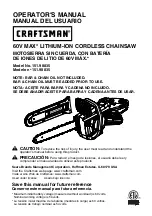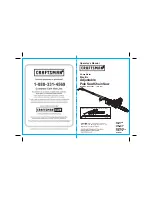
15
•
Limbing a tree
Limbing is the process in which branches are removed from a
fallen tree. When limbing, leave larger lower limbs to support
the log off the ground. Remove the small limbs in one cut as
illustrated (Fig. 19). Branches under tension should be cut from
the bottom up to avoid binding the chain saw.
m
WARNING!
Pay special attention to where the branches
are lying on the ground and recognize the following risks:
1) the branches may be under tension; 2) the direction in which
the branch will fall may differ from that anticipated; 3) the tree
may be unstable after the branch has been cut.
•
Bucking a log
Bucking is the process in which a log is cut into lengths. It is
important to make sure your footing is firm and your weight is
evenly distributed on both feet. When possible, the log should
be raised and supported by the use of limbs, logs, or chocks.
Follow these simple directions for easy cutting:
i) When the log is supported along its entire length as
illustrated (Fig. 20A), cut from the top (overbuck).
ii) When the log is supported on one end (Fig. 20B), cut 1/3
the diameter from the underside (underbuck). Then make
the finishing cut by overbucking to meet the first cut.
iii) When the log is supported on both ends (Fig. 20C),
cut 1/3 the diameter from the top (overbuck). Then make
the
finishing cut by underbucking the lower 2/3 to meet
the first cut.
1
2
1
Fig. 19
1
Fig. 20A
1
2
Fig. 20B
1
2
Fig. 20C






































